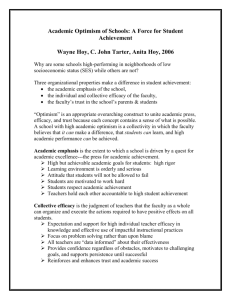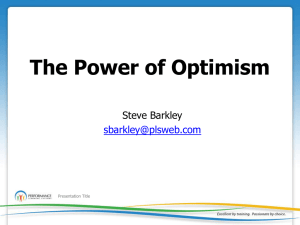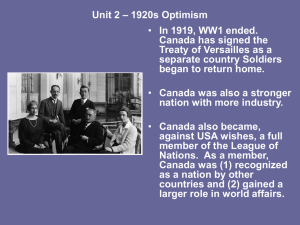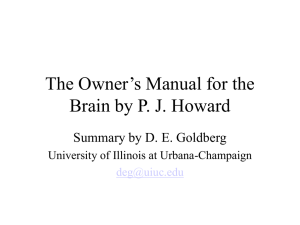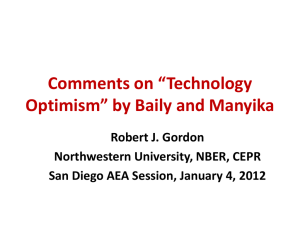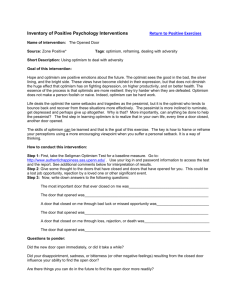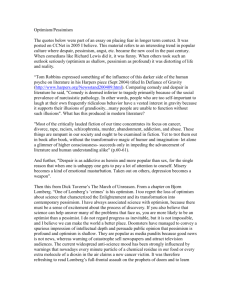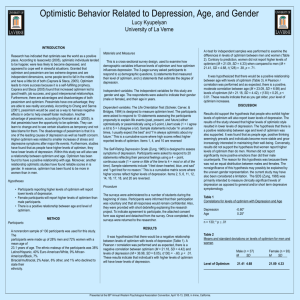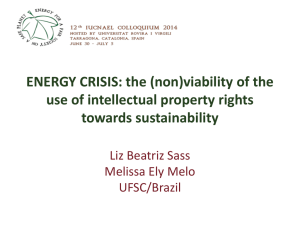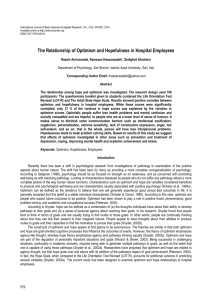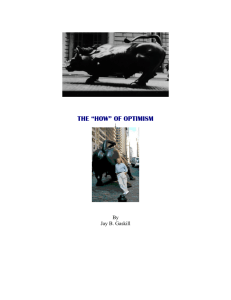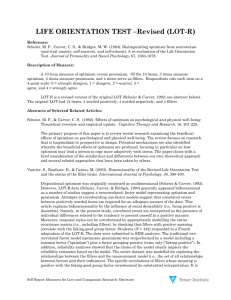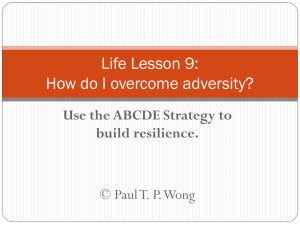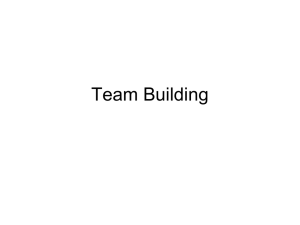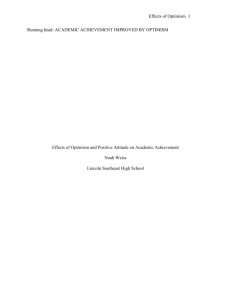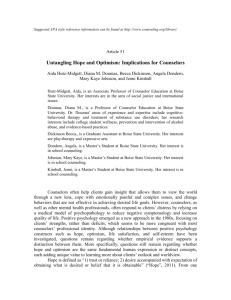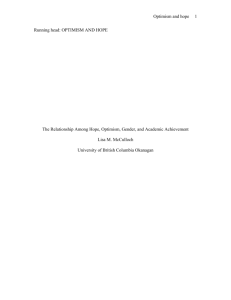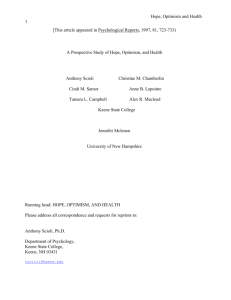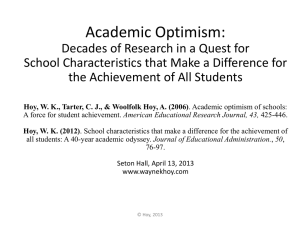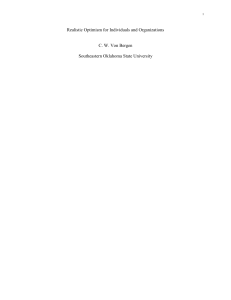Academic Optimism
advertisement
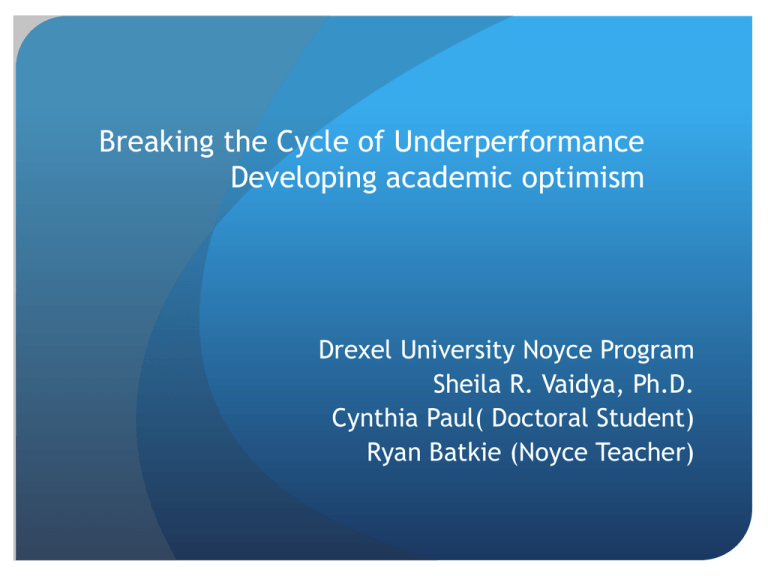
Breaking the Cycle of Underperformance Developing academic optimism Drexel University Noyce Program Sheila R. Vaidya, Ph.D. Cynthia Paul( Doctoral Student) Ryan Batkie (Noyce Teacher) High Need Schools & Teacher Performance -As I visited the high need schools where Noyce teachers were placed, I wanted to know how we were making a difference in high need schools. -High-poverty, low-performing schools fight a constant uphill battle to recruit and retain teachers and principals. -They have more trouble attracting enough experienced applicants, lose staff at a much higher rate (over one in five teachers every year), and must fill vacancies again and again with lessqualified candidates. Data from the Education Trust -Data from the Education trust conveyed that in high need schools- high poverty, low performing schools, teachers are twice as likely to have less experience, lack certification and about 70% typically would be teaching out-of field. Kati Haycock - Closing the Teacher Quality gap- the poorer the student, the less qualified the teacher; one often sees “dreadful teaching” in the highest poverty schools. Teacher Performance differences I visited several classrooms, obtained Achievement test data, talked to Principals and I could see that some of our teachers were turning around the cycle of underperformance while others were doing what was needed. But it took leadership and strong beliefs to do more Overhaul the curriculum Transforming the school’s self-image: 2006-2010 Design and create a Physics lab Master teaching The differences I began to wonder what it is about the teachers that was making a difference? All of them had the content knowledge, the pedagogical knowledge, technology knowledge- so I began to look into the literature and came across a concept that was being developed by Anita Wolfolk, Wayne Hoy (2006, 2009) at Ohio State University- they called this characteristic “Teacher’s academic Optimism” Academic Optimism They said that they too found that teacher’s academic optimism was a construct that they had studied and developed a theoretical measure of It challenged the findings of the Coleman report about the socioeconomic status continuing to impede student learning and that teacher beliefs were having an impact. Teachers who find purpose in their work • Believe all students can learn • we need to find ways to teach them • Teachers are high in self-efficacy • Demonstrate academic optimism • Teachers who stay • Talk to their students What is Teacher Academic Optimism? Teacher Academic Optimism is a set of beliefs held by individual teachers that: I can teach effectively. I trust my students to learn and their parents will support me. Thus I can set the bar high and emphasize academics. Researchers Hoy et al. – Academic Optimism is esp. attractive because it emphasizes the potential of schools to overcome the power of socioeconomic factors that impair student achievement. Evolution of the concept The construct is emerging from research on positive psychology, optimism, social capital and collective school properties that make a difference in the achievement for all students. Theoretical foundations of academic optimism are Bandura’s social cognitive and self-efficacy theories Coleman’s social capital theory Hoy et al. –their work on school culture and climate Seligman’s study of learned optimism Academic Optimism of Schools Collective efficacy- perception of teachers in a school that the efforts of the faculty as a whole will have a positive effect on students. Collective efficacy is a belief or expectation; it is cognitive. Collective faculty trust in students and parents is an affective response. Individual sense of academic optimismcritical for high need schools Sense of teacher efficacy-a judgment of his or her capability to bring about desired outcomes of student engagement and learning, even among those students who may be difficult or unmotivated (Wolfolk Hoy, 1998). Teacher’s sense of efficacy- a belief that they can affect student learning- thus resulting in teachers setting high expectations, exerting greater effort and are more resilient when things are difficult. Teacher trust in parents & students- leads to high teacher expectations. Teacher sense of academic emphasis: active student engagement in worthwhile learning activities that make sure student progress occurs. Academic Optimism Scale Academic Optimism- a teacher’s belief that she can make a difference in the academic performance of students by emphasizing academics and learning, by trusting parents and students to cooperate in the process and by believing in her ability to overcome difficulties and react to failure with resilience and perseverance. Noyce Teachers grouped as effective based on our observation, school data, principal perception which also included parental input. Test Items 1. I encourage my students to really think through their answers. 2. I trust the parents of my students. 3. I can count on parents for help. 4. I have confidence in my students. 5. I press my students to achieve academically. 6. I believe what parents tell me. 7. I believe what students tell me. 8. I give my students challenging work. Test Items 1. How much can you establish a classroom management system with each group of students? 2. How much can you do to control disruptive behavior in the classroom? 3. How much can you do to get students to believe they can do well in school work? 4. How much can you do to motivate students who show low interest in school work? 5. How much can you do to help your students value learning? Sonia Nieto- What keeps teachers going? (2003) Providing a counter narrative to the prevailing view that the way to improve education is to “fix” teachers or “fill them up” with best practices- arguing for an alternative view point-teaching is relational and is fundamentally about forming connections that scaffold learning. Cultivate academic optimism? Critical Pedagogy as a theoretical framework for urban education Advocates educators to become classroom researchers; by becoming researchers of their own classrooms, educators can reflect on their practice and influence discussions about effective pedagogy. Commitment to justice, a central tenet of critical pedagogy. Teachers as agents of change; teaching students to question and engage in critical thinking- need to believe in a strong goal/mission. 2006 – Low Math Achievement Urban Charter School, grades K-8 Northeastern United States Very high staff turnover (about 40%) Stable student population 50% to 80% free and reduced lunch Teachers young, inexperienced, first year teaching Math not a strength Math program in 2006 Grades K-6 : popular reform math curriculum Grades 7-8 : transition math and algebra books After three years using a new program… Math Achievement from 2006 - 2009 Information Processing Theory (Miller) •Working memory is “chunked” •Seven plus or minus two “chunks” at one time Learning Framework Constructivist Theory (Bruner) • Learning is an active process • Students construct their own knowledge • Based on prior knowledge Literature Review Math fact automaticity Royer (1999) - Math fact retrieval speed correlated with math achievement Careful use of calculators Prior knowledge matters 4th Hembree (1986) Meta-analysis of calculator use U.S. Department of Education (2008) Foundations for Success: The National Mathematics Advisory Panel Final Report. Significance of curriculum grade is key year Foundation of basic skills critical (computation, fractions) Rittle-Johnson (2008) Generate vs Read answers Whitehurst (2009) effect size of curriculum = .30 Synthesis of empirical research on teaching math to low achieving students Baker, Gersten, Lee (2002) 1). Specific feedback; 3). Regular and frequent parent feedback; 2). Peer tutoring; 4). Direct or explicit instruction when needed • Supplemental Curriculum that emphasized basic skills with explicit instruction • Easily implemented by new and inexperienced teachers & substitutes • Progress Monitoring for Math Facts • Problem Solving • Test Analysis • Vertical Integration • Pacing • Benchmarks • Specific class and student feedback to teachers • PSSA Checklist • Math Notebook • Responsible for all math K-8 • Troubleshooting • Academic Leadership Team • Overall Guidance Curriculu m Leadership Overall System Motivation • Weekly Contests • Monthly Contests Research 2010 Determine Fidelity to Original Program On Site Feb – June 2010 School now has total 34 classrooms (not evenly distributed through grades) Observed in 16 classrooms (47%) Interviewed 12 teachers (40%) Interviewed 4 administrators (new math support team and Chief of Staff) Findings Program remains in place Significant additional resources allocated to math 3 support personnel (up from 1.5) Additional 180 minutes per week devoted to math Continued student success One Year Later – Math Program Remains in Place Higher Student Achievement More resources Math program. School develops reputation as math school Students are more confident Cycle of Optimism School is energized Teacher & student optimism & achievement Teachers are more confident Teachers & students have higher expectations References Baker, S., Gersten, R., & Lee, D.-S. (2002). A synthesis of empirical research on teaching mathematics to low-achieving students. The Elementary School Journal, 103(1), 52-73. Hembree, R., & Dessart, D. J. (1986). Effects of hand-held calculators in precollege mathematics education: A meta-analysis. Journal for Research in Mathematics Education, 17(2), 83-99. Rittle-Johnson, B., & Kmicikewycz, A. O. (2008). When generating answers benefits arithmetic skill: The importance of prior knowledge. Journal of Experimental Child Psychology, 101, 75-81. Royer, J. M., Tronsky, L. N., Chan, Y., Jackson, S. J., & Marchant, H. (1999). Math fact retrieval as the cognitive mechanism underlying gender differences in math test performance. Contemporary Educational Psychology, 24, 86-267.

